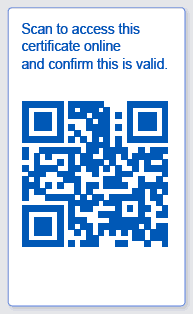QR Codes on Universal Certificates
- Clyde Anderson
- Feb, 20, 2018
- Energy Assessment Tools
- Comments Off on QR Codes on Universal Certificates
You might have noticed that your Universal Certificate has a small QR Code, but what do these QR Codes do? 
First off, if you’re not sure what a Universal Certificate is, we’ve written a great summary article explaining why a Universal Certificate is so important!
Each Universal Certificate’s QR Code links to a digital copy of this report on the Universal Certificate Portal.
This is partly because it’s much easier to share a digital link than a physical copy of the Certificate. The certificate also offers transparency on the assumptions & data used in the thermal modelling; simplifying the process of inspecting buildings for Code compliance! Thus, helping industry practitioners get the building right.
QR Codes are an important security measure!
Physical reports & PDFs can be altered with a bit of technical know-how, but changing the details on the Universal Certificate Portal is another matter. Because of this, we always recommend using a digital copy found through the Universal Certificate Portal over other versions. Even a quick check against the online copy to make sure things match could save you headaches later on.
This accountability goes much farther than just hosting it on a secure website. All NatHERS-accredited software can generate Universal Certificates. In fact, it’s a breach of the Assessor’s ‘Software User Licence Agreement’ to not produce a NatHERS Universal Certificate. This means your assessment was done the right way, by properly trained people.
Simply scan the QR Code with your smartphone, which will link you to a web Portal containing the unique certificate for that dwelling. If your phone doesn’t have a QR Code scanner, you can find free barcode scanners in your phone’s app store. Once you’ve got the Universal Certificate open, check that the certificate number & address matches your project just to be sure it’s the right one. You can view all the other elemental details of the dwelling in the report, in a simple standardised format
Mini Certificates?
Sometimes the full Universal Certificate might not be provided with the assessment report. This could be the case on very large projects, such as a block of units. In these cases the mini-certificate can be used instead, since this helps retain brevity of the assessment report. However, the QR Code must be provided so you can still verify the construction details for each Unit.
Going by the rules in the NatHERS Technical Notes, QR Codes should be added electronically to each ‘principal page’ of the project drawings (e.g. cover sheet, floor plans, elevations & specifications). You can access the full Universal Certificate from the supplied QR Code; giving you additional accountability and easy reminders to check that everything matches up.
Your Protection Against Phonies!
As part of every accredited assessor’s quality assurance process, the “Assessor Accrediting Organisation” (AAO) stamp should also be added to the principal drawing pages. This shows the assessment result has been lodged with the appropriate AAO for technical auditing. Using the AAO stamp without lodging the assessment with the relevant AAO is a breach of their Code of Conduct, and those violations are taken very seriously.
NatHERS and the AAO’s are aware of some assessors who have manufactured “example” Universal Certificates that they try to pass off as the real thing! Aside from being invalid certificates, these assessments usually aren’t done to NatHERS standards. Therefore they don’t accurately reflect the actual thermal performance of your building.
The easiest way to verify if you’ve got an authentic certificate is by checking the QR Code for the Universal Certificate with its unique certificate number.
Don’t risk someone trying to ‘do a dodgy’ with your report! Check the QR Code to make sure you’ve received what you’ve paid for!
